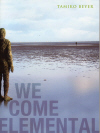We Come Elemental
We Come Elemental is Tamiko Beyer’s first full-length book; her chapbook bough breaks was published by Meritage Press in 2011. While bough breaks focused primarily on “domestic” concepts (gender, sexuality, motherhood, adoption), We Come Elemental draws from the entire planet for its topics. Water comprises the framework by which these disparate subjects are connected, just as water serves to connect all life on Earth.
We Come Elemental is Tamiko Beyer’s first full-length book; her chapbook bough breaks was published by Meritage Press in 2011. While bough breaks focused primarily on “domestic” concepts (gender, sexuality, motherhood, adoption), We Come Elemental draws from the entire planet for its topics. Water comprises the framework by which these disparate subjects are connected, just as water serves to connect all life on Earth.
It was tempting to read this book, the first two sections in particular, as ecopoetry. Beyer had previously contributed both the title poem and the book’s opening poem, “Look Alive, Dark Side,” to the Poets for Living Waters project. This poetry forum began initially as a response to the 2010 oil spill in the Gulf of Mexico but continues to publish ecologically-oriented work, motivated, according to their website, “by the belief that poetry helps release us from moral platitudes, returns us to our bodies, returns us to our senses.” The book’s title itself proclaims the human “we” as elemental, just another element, another part of the world.
Though it is indeed tempting, and easy maybe, to read We Come Elemental as ecopoetry, the book is much more than that. Throughout the first section, Beyer’s ecological sensibility is obvious but not at all simple. She writes about the island of plastics found in the Pacific Ocean in “Trash Sail,” a fragmented poem which breaks down words in the way that “every little piece of plastic manufactured / fifty years” does not. She writes not only about the Gulf oil spill, but also about Hurricane Katrina in “Wade,” which incorporates lines from former FEMA director Michael Brown’s Congressional testimony. Many of the poems in the first section also contemplate the connection of human to nature, a connection we often try to deny. The final stanza of “Look Alive, Dark Side” reads:
Beach walking we
who siphon the wet
step about dumb
lumps gleaming
in moonlight’s pull:
creatures the tide
abandons to the shore.
We are not at all like them.
Extinction also seems to be a theme: in the short poem “When All,” which begins, “Now the bumblebees and now the white-nosed bats. / All the colors. The disappeared frogs” and even more so in the second section of the book, the single long poem called “Dear Disappearing.” But those disappearing are much more than endangered species. The section’s epigraph refers to Antony Gormley, an artist whose “Another Place” project sunk a hundred sculptures in the ocean to investigate the effects of time and erosion; Gormley’s work is referenced, or may be referenced, in many places throughout the poem. Humans also are among those threatened by disappearance, threatened by pleasure and desire (“I give you cause / you give back loss”), by gender politics (“my body discounted in the war of many meanings”), by war (“did we not build / the bomb the big one the one to end all ones?”), by greed (“Children of pleasure we make and take we spectate / . . . Greedy our fingers thorn-scarred and still hungry”).
And yet, the poem ends in peace: “Hush / and we listen to that gorgeous / chest heartbeating ocean.” A connection both human and natural, and one which moves far beyond moralizing to pure experience.
Further complicating an ecopoetic reading, the final section of the book shifts attention more toward the human, the interpersonal, toward love and gender, but as with the environmental themes, not in a simple way. In “Continuity,” for example, Beyer writes:
And so gender becomes
an object. You want a looseness that makes me
nervous. I want to become the woman your parents
never dreamed for you.
In the final section, the poems invoke Deleuze and Guattari (in “Flickering Toward Definition”) and Walt Whitman (in both “Water East” and the final poem, “Talking Into Each Other’s Mouths”); such diverse influences are not surprising in a book that is both theoretical and expansive.
In spite of this expansiveness, Beyer manages to connect all the threads of her topics using the element of water; whether oceans, rivers, or rain, water is the current that moves and swirls throughout the book. Yet even the water is complicated by imagination; the final poem sees the speaker and her partner discussing ruin: “You say, ‘If the Cumbre Vieja volcano erupts, / half the island of La Palma will plunge into the sea and then . . .’” But the speaker of this book, despite all her fragmentation, ends with a heartening exhortation, grounded in imagination and love. “Draw up the sail, sweetheart,” she says in the last stanza. “Our room’s a tight box ship. We billowy milk and wet paper / take the hit and spindrift. We wave and wave and wave.”
What Beyer has created in We Come Elemental is a universe in miniature, a collection of lyrics encompassing the world, its degradation and its beauty both.





